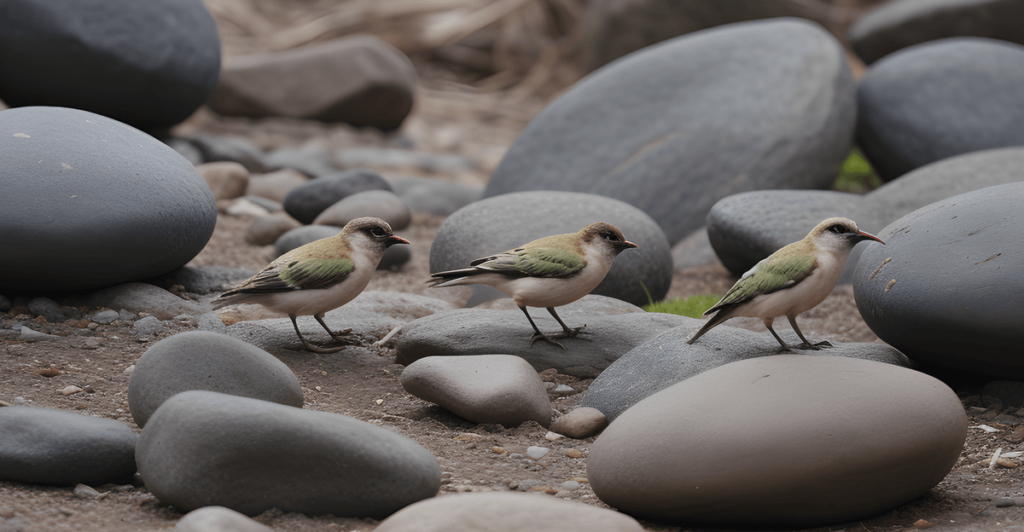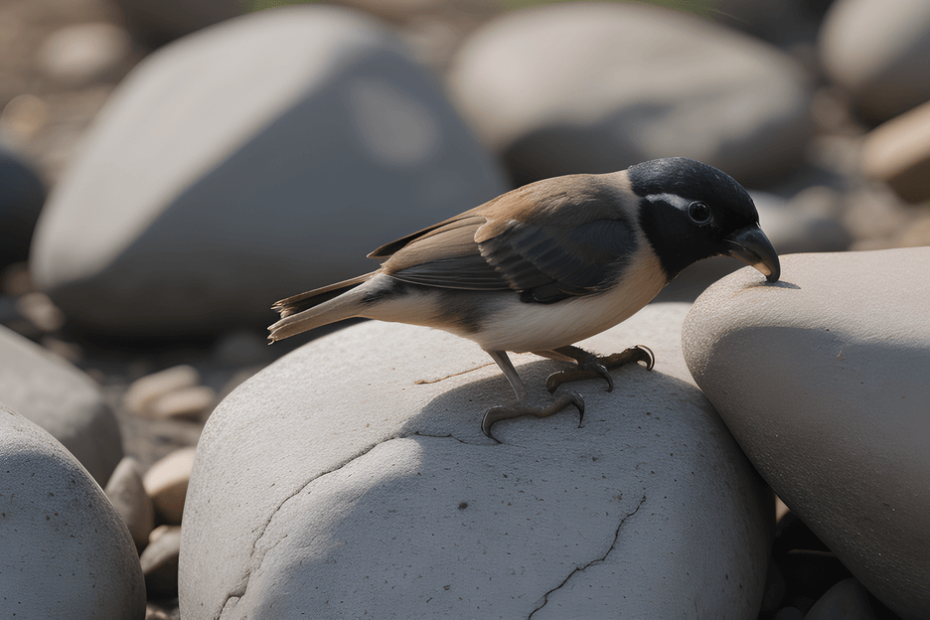Key Takeaways
- Birds eat rocks to aid in digestion by using them in their gizzards to grind food.
- Understanding the role of gizzards, gastroliths, and the digestion process in birds helps explain this behavior.
- Gizzards play a significant role in birds’ digestive systems, similar to other animals.
- Birds consume stones as part of their natural dietary habits for better digestion.
- Different types of stones, such as grit or pebbles, are consumed by birds.
- Observing when and how birds swallow rounded rocks provides insights into their digestion process.
Introduction
Ever wondered why birds munch on rocks? Let’s dive into the intriguing world of avian behavior and explore the reasons behind this curious phenomenon involving many birds. From aiding digestion to obtaining essential nutrients, there’s more to this rock-eating habit than meets the eye. Join me as we unravel the mystery behind why birds have a penchant for pecking at stones.
Why Do Birds Eat Rocks?
Common Behavior?
Birds consuming rocks might seem unusual, but it’s a surprisingly common behavior among various avian species. This behavior is not limited to just one type of bird; in fact, many different birds engage in this peculiar activity. For instance, some birds like turkeys and certain types of waterfowl are known to ingest rocks regularly.
Some researchers believe that this behavior could have been inherited from their dinosaur ancestors. Fossils of dinosaurs and ancient marine reptiles often contain rocks within their stomachs, suggesting that rock consumption has deep roots in evolutionary history.
Reasons for Rock-Eating Habits
One prevalent theory behind why birds eat rocks is related to aiding digestion. The ingested rocks help grind up tough food items like nuts or seeds in the bird’s gizzard (a specialized part of the stomach). By using these swallowed stones as grinding tools, birds can break down hard substances more effectively.
Another possible reason for this behavior is linked to obtaining essential minerals lacking in their regular diet. Some rocks may contain trace elements vital for a bird’s health that they cannot acquire solely from their feed. Ingesting specific types of stones can supplement these missing nutrients and support overall well-being.
I remember reading about an interesting study where scientists found that seals also consume small pebbles alongside fish bones to assist with digestion by breaking down food particles inside their stomachs!
The Role of Rocks in Birds’ Digestive Systems
How Rocks Aid in Bird Digestion
Birds have a unique way of processing food. Rocks play a crucial role in aiding birds’ digestion by helping them break down tough food items like seeds and nuts. When birds ingest small, rounded rocks, these act as grinders inside their gizzards to pulverize food into smaller particles for easier digestion.
Including rocks in their diet allows birds to effectively grind down hard substances that their beaks cannot break apart. This grinding process helps extract essential nutrients from the food they consume. By incorporating rocks into their digestive system, birds can maximize the nutritional benefits of various foods.
Importance of Rocks for Birds’ Digestive Health
The presence of rocks is vital for maintaining the health and functionality of birds’ digestive systems. Without these small stones, some bird species may struggle to digest certain types of foods properly. By aiding in the breakdown process, rocks prevent blockages or indigestion issues within a bird’s digestive tract.
Incorporating rocks into their diet ensures that birds can efficiently absorb nutrients from the different types of foods they consume daily. This natural mechanism not only supports healthy digestion but also contributes to overall well-being and vitality among bird populations.
Rocks as Essential Components in Birds’ Gut Processes
For many bird species, rocks are indispensable components in ensuring optimal gut processes throughout the digestion cycle. These tiny stones help maintain pH levels within the stomach and facilitate the mechanical breakdown necessary for extracting nutrients effectively from consumed foods.

Understanding the Gizzard and Gastrolith in Birds
The Importance of Gizzards in Birds
Birds lack teeth to chew their food, so they have evolved a specialized organ called the gizzard. This muscular part of a bird’s digestive system grinds down food using small rocks or grit that the bird swallows. The gizzard acts as a powerful millstone, breaking down seeds and tough plant material.
The gizzard is lined with strong muscles that contract and relax to crush food effectively. By consuming rocks or grit, birds aid their digestion by mechanically breaking down tough items like seeds and fibers. For instance, chickens swallow tiny stones which help them grind up hard grains for better absorption.
Gastroliths: Nature’s Digestive Aid
Gastroliths, also known as stomach stones, are the rocks or pebbles that birds ingest intentionally to assist in grinding up their food inside the gizzard. These smooth stones help pulverize seeds and other challenging parts of plants before they move on to be further digested in the intestines.
In some cases, birds might accidentally ingest these rocks while feeding but most often they actively seek out suitable gastroliths for consumption based on size and shape requirements dictated by their species’ needs. For example, ostriches consume large pebbles whereas smaller birds opt for finer gravel.
Personal Insights:
I find it fascinating how birds have adapted over time to utilize natural resources like small rocks to aid in digestion efficiently within their bodies.
Significance of Gizzards in Birds and Other Animals
Evolutionary Advantages
Gizzards play a crucial role in the digestive systems of various species, especially birds. Evolutionarily, gizzards have provided significant advantages for avian species over time. The muscular organ’s main function is to grind food, aiding in the digestion process.
Birds lack teeth, so gizzards act as their grinding mechanism, breaking down food particles into smaller pieces for better absorption. This adaptation has allowed birds to efficiently digest tough materials like seeds and grains that would otherwise be challenging to break down with just saliva and enzymes. For example, ostriches use their powerful gizzard muscles to crush hard items like pebbles or rocks they ingest along with food.

Anatomical Efficiency
The presence of gizzards in various animals showcases efficient digestion processes across different species. Not only do birds possess this unique feature, but some fish and reptiles also have similar adaptations. The muscular walls of the gizzard contract rhythmically to aid in grinding food mechanically before it moves on to further digestion stages.
In addition to aiding digestion through mechanical breakdown, gizzards also serve as a storage compartment for grit or small stones that help grind down ingested food effectively. By incorporating these abrasive substances into their diet intentionally or unintentionally (such as when accidentally consuming gravel), birds ensure the proper breakdown of tough foods like seeds or nuts.
Dietary Habits of Birds: Consuming Stones for Digestion
Importance of Stone Consumption
Birds often swallow stones as part of their diet. These stones help grind up food in the gizzard, aiding digestion. The gizzard is a muscular organ found in birds that helps break down tough foods like seeds and nuts.
Stones act as grinding tools inside the bird’s gizzard, helping to crush hard-to-digest items such as seeds and insects. By consuming stones, birds can effectively process their food, ensuring proper nutrient absorption. This unique adaptation showcases how birds have evolved to optimize their dietary habits for survival.
Nutritional Benefits of Stone Ingestion
The ingestion of stones plays a crucial role in the digestive process of many bird species. When birds consume food, some parts remain undigested because they are challenging to break down completely. Stones aid in breaking down these undigested food particles by physically grinding them into smaller pieces within the gizzard.
I remember watching a documentary where they showed how certain bird species actively seek out specific types of stones based on their size and shape to assist with digestion efficiently. It was fascinating to see this natural behavior firsthand and understand its importance for the birds’ overall health.
Examining Bird Diet Through Stone Ingestion
By observing which types of stones different bird species swallow, researchers can gain insights into their diets. For example, carnivorous birds may consume smaller pebbles compared to herbivorous ones that require larger rocks for better digestion efficiency. This variation in stone selection offers valuable clues about the nutritional needs and feeding behaviors across various bird populations.
- Pro: Enhances digestive capabilities
- Pro: Facilitates nutrient absorption
- Con:
Types of Stones Consumed by Birds
Variety
Birds consume various types of stones depending on their species and habitat. Some birds prefer small, smooth stones, while others opt for larger, rough ones. For instance, pigeons often ingest tiny pebbles to aid in digestion.
I find it fascinating that different bird species have distinct preferences. This diversity showcases how adaptable birds are in utilizing resources available in their environment.
Characteristics
The stones consumed by birds serve specific purposes such as aiding in grinding food in the gizzard or providing essential minerals. Birds carefully select these stones based on their characteristics like hardness and smoothness. For example, ostriches swallow harder rocks compared to sparrows due to differences in their digestive systems.
It’s intriguing how birds instinctively know which type of stone is suitable for their needs. Their ability to choose stones based on characteristics like hardness highlights the innate intelligence present even in seemingly simple behaviors.
Common Types
Among the common types of stones found in birds’ diets are gravel, grit, and calcium-rich particles like eggshells. Gravel helps grind down food for easier digestion while grit aids in breaking down tough seeds or nuts within a bird’s gizzard.
In my experience observing backyard birds, I’ve noticed them seeking out gravel from driveways or paths after heavy rainfalls. This behavior aligns with their natural inclination towards consuming specific types of stones beneficial for digestion.
Behavioral Patterns: When and How Birds Swallow Stones
Timing of Ingestion
Birds often consume rocks as part of their feeding routines, especially before or after meals. This behavior is particularly common among birds that lack teeth to grind food effectively. The ingestion of stones aids in breaking down food in the gizzard, a muscular part of the stomach.
Some birds ingest stones strategically before consuming prey to assist in grinding it into smaller pieces for easier digestion. For instance, ostriches swallow pebbles to help break down tough plant material and seeds they eat. This timing ensures efficient processing of food inside the bird’s digestive system.
Swallowing Techniques
Birds have developed various techniques to swallow stones efficiently. They select smooth and round stones that are less likely to cause damage internally while aiding in digestion. Seabirds like gulls are known for swallowing small pebbles found along beaches or rocky shores.
Moreover, some species exhibit specific behaviors when swallowing stones; pigeons typically pick up small gravel pieces using their beaks and then tilt their heads backward to successfully ingest them. These techniques ensure that the swallowed stones reach the gizzard where they play a crucial role in aiding digestion.

Observing Behavioral Cues
To understand birds’ stone consumption habits better, observing behavioral cues is essential. One prominent cue is watching birds actively searching for suitable-sized rocks near water bodies or on gravel paths. For example, penguins often pick up small stones from the ground with their beaks before heading back to their nests.
Noticing changes in a bird’s posture while ingesting rocks can provide insights into this behavior; an upright stance combined with repeated head movements may indicate stone ingestion activity taking place within the bird’s digestive system.
Exploring the Phenomenon of Birds Eating Stones
Influence on Stone Consumption Habits
Birds’ stone-eating habits are influenced by various environmental factors. Many birds consume stones to aid in digestion, especially herbivores that need help breaking down tough plant material. The stones grind against food inside the bird’s stomach, acting as a makeshift grinding mill.
Stones also play a crucial role in providing essential minerals and aiding in buoyancy for swimming birds like penguins. Birds living near sandy areas may ingest small pebbles accidentally while picking up food or drinking water. This unintentional consumption of stones can sometimes be beneficial for their digestive system.
Impact on Avian Species
The act of consuming stones is not just a random behavior but holds cultural significance among avian species. Research suggests that some birds eat rocks to help with eggshell formation by providing calcium from the ingested stones. Paleontologists have found evidence of rock consumption dating back millions of years, indicating its importance throughout evolutionary history.
Beach-dwelling birds often swallow small pebbles to assist in grinding down hard-shelled prey like crabs and mollusks before digestion. This unique feeding strategy showcases how birds adapt to their environment and utilize resources available to them efficiently.
Historical Importance
Stone-eating behaviors have been observed across many bird species worldwide over centuries, highlighting the long-standing tradition among avian communities. Some indigenous cultures believe that certain types of rocks hold medicinal properties and encourage stone consumption by sick or injured birds for healing purposes.
In some regions, local folklore associates stone ingestion with improved hunting skills or better navigation abilities for migratory birds during long journeys across continents.
Ethological Aspects
Understanding why do birds eat rocks delves into ethology—the study of animal behavior within natural environments—revealing fascinating insights into avian cognition and adaptation mechanisms based on ecological needs. By examining these behaviors closely, scientists gain valuable knowledge about the intricate relationship between animals and their surroundings.
Personal Insight: I find it intriguing how seemingly simple acts like eating rocks can unveil profound connections between wildlife behaviors and environmental influences, showcasing nature’s incredible complexity.
Comparative Analysis: Birds’ Gizzards vs Other Species
Functions of Gizzards
Birds have a unique digestive organ called the gizzard. Unlike many animals, birds do not have teeth to grind their food. Instead, they swallow small rocks or pebbles that travel to the gizzard. The gizzard uses these stones to help break down food into smaller pieces for better digestion.
The gizzards in birds play a crucial role in grinding tough foods like seeds and nuts that are hard to break down with just saliva and stomach acids. In contrast, humans and other animals rely on teeth for chewing food before it reaches the stomach for further breakdown.
Adaptations Across Species
When comparing bird gizzards with other species, it’s interesting to note how different animals have adapted their digestive systems based on their diets and lifestyles. For example, herbivores like cows have multiple stomach compartments that aid in fermenting plant matter efficiently.
In aquatic animals such as whales, adaptations focus more on buoyancy rather than grinding food since they swallow prey whole or in large chunks due to their feeding habits. This highlights how various species have evolved specialized digestive systems tailored to their specific dietary needs.
Unique Aspects of Avian Gizzards
Avian gizzards stand out due to their muscular walls lined with thick layers designed for powerful grinding action compared to the simple stomachs found in some mammals like humans. These muscular organs can make up around 1-2% of a bird’s total body mass, showcasing their importance in the digestion process.
One fascinating aspect is how certain birds can even control the size of stones they ingest depending on what type of food they eat regularly – a remarkable adaptation that showcases nature’s efficiency at work.
Summary
After diving into the world of birds munching on rocks, it’s crystal clear that these stones play a crucial role in their digestion. Exploring the ins and outs of gizzards and gastroliths has revealed how birds use this unique strategy to break down food. The comparison with other species showcases the distinctiveness of birds’ digestive systems and highlights the importance of understanding these feathered creatures’ dietary habits.
So, next time you spot a bird pecking at a pebble, remember, it’s not just a random act – it’s nature’s way of aiding their digestion. Stay curious about the wonders of the animal kingdom and keep exploring the fascinating behaviors that make our world so diverse.
